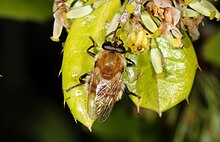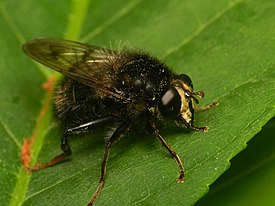Criorhina
Appearance
| Criorhina | |
|---|---|

| |
| Criorhina berberina female | |
| Scientific classification | |
| Domain: | Eukaryota |
| Kingdom: | Animalia |
| Phylum: | Arthropoda |
| Class: | Insecta |
| Order: | Diptera |
| Family: | Syrphidae |
| Subfamily: | Eristalinae |
| Tribe: | Milesiini |
| Subtribe: | Criorhinina |
| Genus: | Criorhina Meigen, 1822[1] |
| Type species | |
| Syrphus asilicus | |
| Synonyms | |
|
Show list
| |
Criorhina is a genus of hoverflies.[16] Medium to large sized species, black or greenish black, with or without light ground markings mimicking bumblebees. The head is much flattened and broader than the thorax. The antennae are situated upon a prominent conical frontal process, The face is moderately produced below the eyes, downward or forward, in profile. The eyes are bare. The abdomen is elliptical or very short oval.[17] Larvae found in rot holes or decaying hardwoods [18]
Gallery
[edit]-
Criorhina asilica (male)
Species
[edit]- C. alexandri Mutin, 1999[19]
- C. apicalis Matsumura, 1916[20]
- C. arctophiloides (Giglio-Tos, 1892)[21]
- C. asilica (Fallén, 1816)[2]
- C. aurea Lovett, 1919[22]
- C. berberina (Fabricius, 1805)[23]
- C. bomboides Hull, 1944[24]
- C. brevipila Loew, 1871[25]
- C. bubulcus (Walker, 1849)[26]
- C. caudata Curran, 1925[27]
- C. coquilletti Williston, 1892[28]
- C. crioarctos Hull, 1944[24]
- C. excavata Curran, 1929[29]
- C. floccosa (Meigen, 1822)[1]
- C. formosana Shiraki, 1930[30]
- C. fusca Weisman, 1964[31][32]
- C. grandis Lovett, 1921[33]
- C. imitator Brunetti, 1915[34]
- C. interrupta Brunetti, 1923[35]
- C. japonica (Matsumura, 1916)[20]
- C. kincaidi Coquillett, 1901[36]
- C. konakovi (Stackelberg, 1955)[37]
- C. kurilensis Mutin, 1999[38]
- C. latipilosa Curran, 1925[27]
- C. nasica (Osburn, 1908)[39][32]
- C. nigripes (Williston, 1882)[9]
- C. nigriventris Walton, 1911[40]
- C. occidentalis (Osburn, 1908)[39][32]
- C. pachymera (Egger, 1858)[41]
- C. pallidipes Curran, 1929[29]
- C. pallipilosa Hull, 1944[24]
- C. portschinskyi (Stackelberg, 1955)[37]
- C. quadriboscis Lovett, 1919[22]
- C. ranunculi (Panzer, 1804)[42]
- C. rostrata Li, Huo & Li, 2020[43]
- C. rubropilosa Hull, 1950[44]
- C. sichotana (Stackelberg, 1955)[37]
- C. simioides (Brunetti, 1908)[45]
- C. spinitarsis Curran, 1929[29]
- C. takaoensis (Shiraki, 1952)[15]
- C. talyshensis (Stackelberg, 1960)[46]
- C. tricolor Coquillett, 1900[47]
- C. tripilosa Coe, 1964[48]
- C. ussuriana (Stackelberg, 1955)[37]
- C. verbosa (Walker, 1849)[26]
- C. villosa (Bigot, 1879)[8]
- "C. villosa" (Bigot, 1882) (Homonym)[10]
- C. vivida Brunetti, 1923[35]
References
[edit]- ^ a b c Meigen, Johann Wilhelm (1822). Systematische Beschreibung der bekannten europäische n zweiflugeligen Insekten. Hamm: Dritter Theil. Schulz-Wundermann. pp. x, 416, pls. 22–32. Retrieved 14 April 2019.
- ^ a b Fallen, C.F. (1816). Syrphici Sveciae. Lundae [= Lund]: Berlingianis. pp. 1–30.
- ^ Meigen, J.W. (1800). Nouvelle classification des mouches a deux ailes (Diptera L.) d'apres un plan tout nouveau. Paris: Perronneau. pp. 1–40.
- ^ Rondani, C. (1845). "Ordinamento sistematico dei generi italiani degli insetti ditteri [part]". Nuovi Ann. Sci. Nat. Bologna 1844. 2 (2): 443–459.
- ^ Rondani, Camillo (1856). Dipterologiae Italicae Prodromus. Vol: I. Genera italica ordinis Dipterorum ordinatim disposita et distincta et in familias et stirpes aggregata. Parmae [= Parma].: A. Stocchi. pp. 226 + [2]. Retrieved 17 October 2020.
- ^ Egger, Johann (1856). "Neue Dipteren-Gattungen und Arten aus der Familie der Tachinarien und Dexiarien nebst einigen anderen dipterologischen Bemerkungen". Verhandlungen des Zoologisch-Botanischen Vereins in Wien. 6: 383–392. Retrieved 3 August 2021.
- ^ Rondani, C. (1857). Dipterologiae italicae prodromus. Vol: II. Species italicae ordinis dipterorum in genera characteribus definita, ordinatim collectae, methodo analitica distinctae, et novis vel minus cognitis descriptis. Pars prima. Oestridae: Syrpfhidae: Conopidae. Parmae [= Parma]: A. Stocchi. pp. 264 pp., 1 pl. Retrieved 3 August 2021.
- ^ a b Bigot, J.M.F. (1879). "[Note.]". Bulletin Bimensuel de la Société Entomologique de France. 1879 (6): 63–64.
- ^ a b c Williston, Samuel Wendell (1882). "Contribution to a monograph of the North American Syrphidae". Proc. Amer. Philos. Soc. 20 (112): 299–332. Retrieved 23 July 2021.
- ^ a b c Bigot, J.M.F. (1882). "Description de quatre genres nouveau de la tribu des syrphides (Syrphidae auctorum), ainsi que celles de deux nouvelles espèces". Bulletin Bimensuel de la Société Entomologique de France. 1882 (6): 78–79.
- ^ Bigot, Jacques-Marie-Frangile (1883). "Diptères nouveaux ou peu connus. 21e partie, XXXII: Syrphidi (1re partie)". Annales de la Société Entomologique de France. 3 (6): 221–258. Retrieved 5 July 2021.
- ^ Bigot, J.M.F. (1884). "Note synonymique". Bulletin Bimensuel de la Société Entomologique de France. 1884 (131): 141–142. Retrieved 14 August 2021.
- ^ Verrall, G.H. (1901). Platypezidae, Pipunculidae and Syrphidae of Great Britain. Vol. 8,In his British flies. London: Gurney & Jackson. pp. [i] + 691.
- ^ Kertész, K. (1910). Catalogus dipterorum hucusque descriptorum. Vol. VII. Budapestini: Museum Nationale Hungaricum. p. 470. Retrieved 6 August 2021.
- ^ a b Shiraki, T. (1952). "Studies on the Syrphidae. 2. Some new species from Japan with an interesting Trypetidae". Mushi. 23: 1–15.
- ^ Stubbs, Alan E.; Falk, Steven J (1983). British Hoverflies: An Illustrated Identification Guide (2nd ed.). London: British Entomological and Natural History Society. pp. 253, xvpp. ISBN 1-899935-03-7.
- ^ Williston, S.W. (1887). "Synopsis of the North American Syrphidae". Bulletin of the United States National Museum. 31: 1–335.
 This article incorporates text from this source, which is in the public domain.
This article incorporates text from this source, which is in the public domain.
- ^ Rotheray, G.E. (1993). "Colour Guide to Hoverfly Larvae (Diptera, Syrphidae) in Britain and Europe" (PDF). Diperists Digest. 9: 155.
- ^ Mutin, V.A.; Barkalov, A.V. 62. Fam. Syrphidae - Pp. 342-500. In Lehr, P. A. (ed.), Key to the insects of Russian Far East. Vol. 6. Diptera and Siphonaptera. Part 1. Valdivostok: Dal'nauka. p. 665.
- ^ a b Matsumura, Shonen (1916). Thousand insects of Japan. Additamenta Vol. 2 (Diptera). Tokyo: Keisei-sha. pp. 185–474 + [4], pls. 16–25.
- ^ Giglio-Tos, Ermanno (1892). "Diagnosi di nuove specie di Ditteri. VI". Bollettino dei musei di zoologia ed anatomia comparata della R. Università di Torino. 7 (123): 1–7. Retrieved 3 August 2021.
- ^ a b Cole, F.; Lovett, A. L. (1919). "New Oregon Diptera". Proceedings of the California Academy of Sciences. 4th series. 9: 221–255. Retrieved 3 August 2021.
- ^ Fabricius, Johann Christian (1805). Systema antliatorum secundum ordines, genera, species. Bransvigae: Apud Carolum Reichard. pp. i–xiv, 1–373. Retrieved 5 June 2020.
- ^ a b c Hull, F.M. (1944). "Some flies of the family Syrphidae in the British Museum (Natural History)". Annals and Magazine of Natural History. 11 (73): 21–61. doi:10.1080/00222934408527401.
- ^ Loew, Hermann (1871). Systematische Beschreibung der bekannten europäische n zweiflugeligen Insecten.Von Johann Wilhelm Meigen. Neunter Theil oder dritter Supplementband. Beschreibung europäische r Dipteren. Zweiter Band. Halle: H.W. Schmidt. pp. viii + 319+[1.
- ^ a b Walker, F. (1849). List of the specimens of dipterous insects in the collection of the British Museum. Part III. London: British Museum (Natural History). pp. 485–687.
- ^ a b Curran, Charles Howard (1925). "Contribution to a monograph of the American Syrphidae north of Mexico". The Kansas University Science Bulletin. (1924) 15: 7–216, 12 pls. Retrieved 23 July 2021.
- ^ Williston, S.W. (1892). "A new species of Criorhinia, with notes on synonymy". Entomological News. 3: 145–146. Retrieved 3 August 2021.
- ^ a b c Curran, C.H. (1929). "New Syrphidae and Tachinidae". Annals of the Entomological Society of America. 22 (3): 489–510. doi:10.1093/aesa/22.3.489.
- ^ Shiraki, T. (1930). "Die Syrphiden des japanischen Kaiserreichs, mit Berucksichtigung benachbarter Gebiete". Mem. Fac. Agric. Taihoku Imp. Univ. 1: xx + 446 pp.
- ^ Weisman, K.E. (1964). "A new species of Sphecomyia (Diptera: Syrphidae) from California". Entomological News. 75: 266–268. Retrieved 5 August 2021.
- ^ a b c Moran, K.M.; Skevington, J.H. (2019). "Revision of world Sphecomyia Latreille (Diptera, Syrphidae)". ZooKeys (836): 15–79. doi:10.3897/zookeys.836.30326. PMC 6477872. PMID 31048958. Retrieved 5 August 2021.
- ^ Cole, F.R.; Lovett, A.L. (1921). "An annotated list of the Diptera of Oregon". Proceedings of the California Academy of Sciences. 11 (4): 197–344. Retrieved 3 August 2021.
- ^ Brunetti, Enrico Adelelmo (1915). "Notes on Oriental Syrphidae, with descriptions of new species, Pt. II". Records of the Indian Museum. 11: 201–256, pl. 13. Retrieved 12 July 2021.
- ^ a b Brunetti, Enrico Adelelmo (1923). Diptera. Pipunculidae, Syrphidae, Conopidae, Oestridae. In: [Shipley, A.E., ed.], Fauna of British India including Ceylon and Burma. Vol. III. London: Taylor & Francis. pp. xii + 424 pp., 6 pls.
- ^ Coquillett, Daniel William (1901). "New Diptera in the U.S. National Museum". Proceedings of the United States National Museum. 23 (1225): 593–618. doi:10.5479/si.00963801.23-1225.593. Retrieved 12 June 2018.
- ^ a b c d Stackelberg, A.A. (1955). "Palearkticheskie vidy roda Penthesilea Mg. (Diptera, Syrphidae)". Entomologicheskoe Obozrenie. 34. Russian: 340–349.
- ^ Mutin, V.A. (1999). "Hover-flies (Diptera, Syrphidae) collected in Kuril Islands in 1998, with the description of a new species" (PDF). Far Eastern Entomologist. 80: 8. Retrieved 5 August 2021.
- ^ a b Osburn, Raymond.C. (1908). "British Columbia Syrphidae, new species and additions to the list". The Canadian Entomologist. 40: 1–14. doi:10.4039/Ent401-1. S2CID 84577629. Retrieved 5 August 2021.
- ^ Walton, W.R. (1911). "Notes on Pennsylvania Diptera, with two new species of Syrphidae". Entomological News, and Proceedings of the Entomological Section of the Academy of Natural Sciences of Philadelphia. 22: 318–322, 1 pl. Retrieved 4 August 2021.
- ^ Egger, J. (1858). "Dipterologische Beiträge". Verhandlungen der Kaiserlich-Königlichen Zoologisch-Botanischen Gesellschaft in Wien. 8: 701–716. Retrieved 3 August 2021.
- ^ Panzer, G.W.F. (1803). "Favnae insectorvm germanicae initia oder Devtschlands Insecten". 91. Nurnberg: 24 pp., 24 pls.
{{cite journal}}: Cite journal requires|journal=(help) - ^ Li, Hu; Hou, Ke-Ke; Li, Bao-Guo (2020). "A new species of the flower fly genus Criorhina Meigen (Diptera: Syrphidae) from mainland China". Zootaxa. 4803 (1): zootaxa.4803.1.9. doi:10.11646/zootaxa.4803.1.9. PMID 33056036. S2CID 222834271.
- ^ Hull, Frank Montgomery (1950). "Studies upon syrphid flies in the British Museum (Natural History)". Annals and Magazine of Natural History. 3 (31): 603–624. doi:10.1080/00222935008654083.
- ^ Brunetti, E. (1908). "Notes on oriental Syrphidae with descriptions of new species. Part I". Records of the Indian Museum. 2: 49–96. Retrieved 4 August 2021.
- ^ Stackelberg, A.A. (1960). "New Syrphidae (Diptera) from the Caucasus". Entomologicheskoe Obozrenie. 39. Russian: 438–449.
- ^ Coquillett, D.W. (1900). "Papers from the Harriman Alaska Expedition. IX. Entomological results (3): Diptera". Proceedings of the Washington Academy of Sciences. 2: 389–464. Retrieved 3 August 2021.
- ^ Coe, R.L. (1964). "Diptera from Nepal. Syrphidae". Bulletin of the British Museum (Natural History) Entomology. 15: 255–290. doi:10.5962/bhl.part.20541. Retrieved 4 August 2021.





